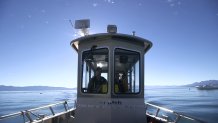For generations, the pristine blue waters of Lake Tahoe have drawn nature lovers escaping their concrete jungles for a forest paradise. And though the area just escaped widespread devastation from the recent Caldor Fire, scientists are still seeing signs of the smoke's impact on the lake's water quality.
Researchers with U.C. Davis' Tahoe Environmental Research Center -- which has documented the lake's water quality since the sixties -- are observing reduced clarity in the lake as a result of smoke from both the Caldor and nearby Dixie Fires.
"We definitely saw a decrease of fifteen feet of clarity that was measurable compared to previous years," said researcher Brant Allen, Field Lab Director for the Tahoe Environmental Research Center. "That was directly related to the smoke."

Get a weekly recap of the latest San Francisco Bay Area housing news. Sign up for NBC Bay Area’s Housing Deconstructed newsletter.
During the brunt of the Caldor Fire which started on August 14, a thick blanket of smoke hung over the Tahoe Basin, raining down ash onto the lake's surface. As the fire bore down on the area, the researchers ramped-up routine water testing to monitor the smoke's impact.
"We were having 600 to 800 AQI here in Tahoe," Allen said, referring to the Air Quality Index. "That is a lot of fine particles sitting over the lake."
A pair of buckets positioned on top of two buoys on the lake captured falling ash as well as its the nutrients in the ash particles which are then analyzed in the center's lab.
Local
The researchers also use a "secchi disc," a white plastic cylinder that's lowered into the lake and used to measure visibility. Late last week, Allen and fellow researcher Katie Senft lowered the disc into the water, noting clarity was still reduced about fifteen feet than normal, even though the smoke had cleared a couple weeks earlier.
"As far as the impacts to the lake go," Allen said, "we don't know yet exactly how lingering effects from the smoke and from potential longer effects from erosion -- we don't know how that going to impact the lake."

Compared to the height of the fire, more recent collecting of ash particles seemed to show the debris was beginning to clear. Senft said during the fire, ash particles were visible in the buckets. But now are difficult to spot with the naked eye.
But the scientists said there was more concern ahead because the Caldor Fire scorched hillsides at the Southern end of Lake Tahoe, where a pair of watersheds supply 30% of the lake's water.
"So say we get some big rain events in the next couple of months this fall," Senft cautioned, "that could wash a lot of that material downstream into the lake."
Senft said an early, heavy rain would be a worst-case scenario -- though snowfall would be more favorable because it would trap the debris in place before it could wash into the lake. The pair of scenarios suggested the area was not yet out of the woods yet, even though the fire is expected to reach full containment by mid-October.
Allen said there were two ways in which the smoke impacted water clarity; the smoke itself blocked sunlight, reducing visibility in the water. Secondly, the ash particles floating in the water also blocked sunlight. The smaller, fine particles were the chief concern -- as larger ash particles sink to the lake's bottom. The smaller particles linger at the surface impacting clarity.
Allen, who has worked on the team monitoring the lake's waters for the last thirty-three years, said he understands the deep concern of the area's residents and admirers.
"I think when you start talking about water clarity, there's more of an emotional value," Allen said. "People know Tahoe for its clarity and that incredible blue color when they're out on the lake."
If there is a bright spot to the area's history, Allen said the water monitoring which began in 1968, at first revealed a decline in clarity during the early decades of testing. But in more recent years, numerous mitigation strategies aimed at protecting the lake have stopped the decline in water quality. But that was before the fires.
Now Allen is closely watching the data, hoping that the impact from the fires will be temporary, despite the threat of erosion in the burned areas.
"That's likely to be a longer impact," Allen said, "and we just don't know yet how that's going to play out."



